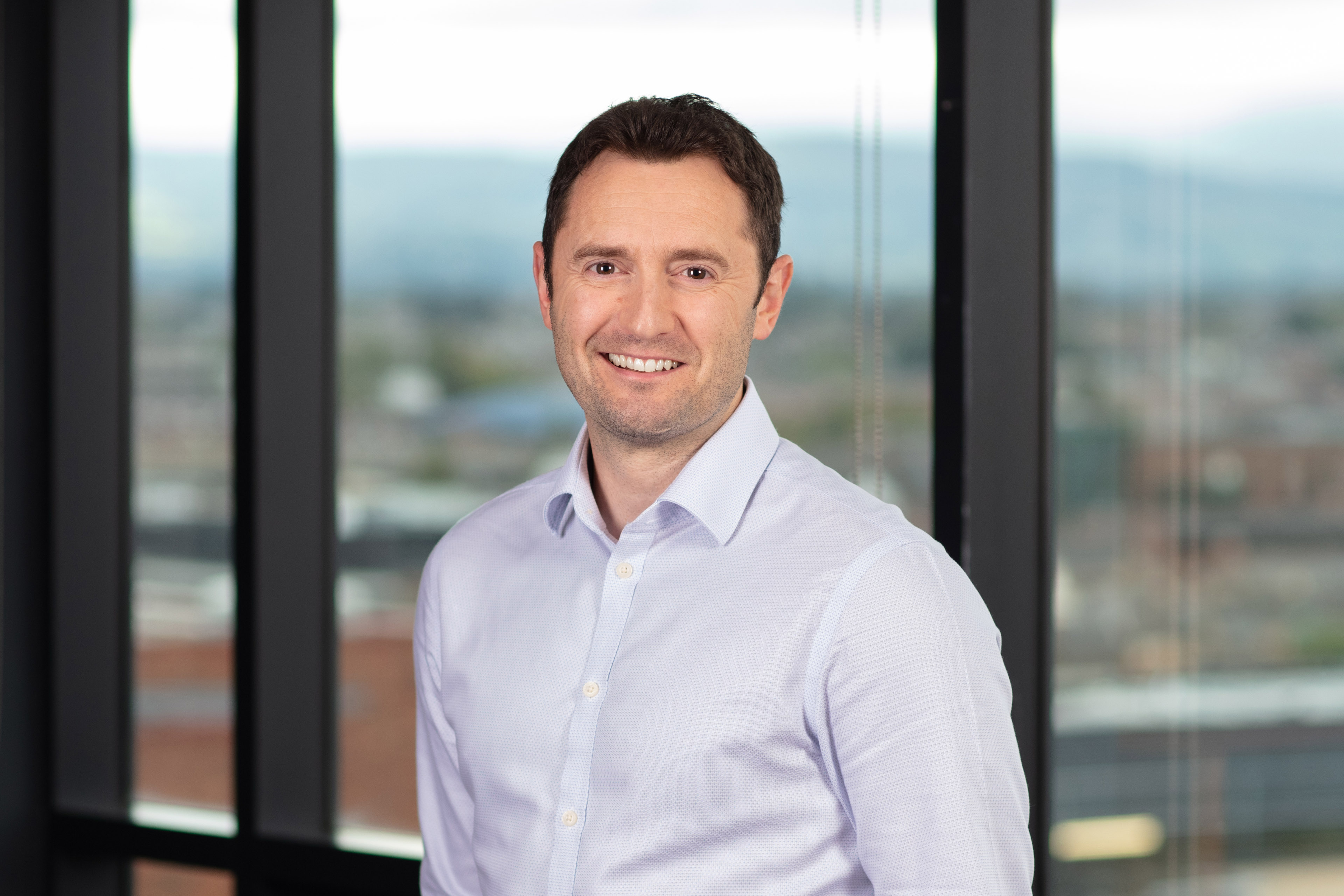
Chapter 1
Pressing ahead with transformation, increase in IT spend
Focus remains on growth whilst future proofing organisations against recession.
The survey highlights technology leaders’ clear focus on transformation to support business growth, help meet market demands and future proof the organisation against recession. More than two-fifths (44%) of the 150 technology leaders surveyed¹ claim they are currently planning or executing a transformation or change programme, indicating a positive mindset despite global uncertainty.
The driving forces behind these transformation programmes are mainly positive with 55% of the respondents saying the primary objective is to improve the quality of products and services. While one-third (33%) say the aim is to meet changing customer demands, 24% say it is to grow revenue and / or market share.
Technology leaders in Ireland clearly have an eye on using change programmes to respond to potential economic headwinds, with cost reduction and future proofing the organisation against recession emerging as key objectives for the transformation.
Primary objectives of transformation initiatives
What are the primary objectives of the initiative?
Our survey results suggest that rather than reduce headcount, organisations are seeking ways to deploy new technology, processes, and data analytics to become more efficient and decisive.
In fact, staff are seen as key contributors to the success of transformation programmes. Responding to the survey, 33% of the technology leaders say that having the right digital and technology-related skills is an important factor for the success of the transformation programme, while right organisational culture was called out by 24%.
Despite continuing market disruptions, and the possibility of a global recession, the mood among technology leaders remains upbeat not just in terms of maintaining momentum for change programmes but also in terms of indicating that there is no sign of any downward pressure on IT budgets.
IT budget

Chapter 2
Skills shortage a top concern
Irish organisations’ growth ambitions are hampered by lack of skills and ability to acquire and retain staff.
Irish organisations are on an upward growth trajectory and, therefore, are in critical need of the right people with the right skills. It is unsurprising therefore that 32% of technology leaders named lack of skills, capacity and ability to retain and acquire staff as the biggest challenge to growth over the next two years, placing it above global recession fears (27%) and supply chain disruption (12%).
Biggest challenge to organisation’s growth over the coming two years
What do you consider to be biggest challenge to your organisation’s growth over the coming two years?
According to the survey, 45% of the technology leaders in Ireland face difficulty in attracting, hiring, and retaining the right talent. Building the right staff augmentation solutions and supporting a hybrid workplace are other key challenges that technology leaders face.
Identification of hybrid working as a challenge is interesting. This is likely a reflection of the issues presented by the changes to working practices prompted by the ending of COVID-19 restrictions. We are seeing more staff return to the office along with a shift away from fully remote to hybrid working as well as the ending of hybrid working in some cases.
The focus on talent is evident in hiring intentions with 93% of respondents saying they intend to either increase their internal IT function capacity and capabilities (37%) or retain current staffing levels (56%) during the next two years. Only 2% indicate an intention to reduce staffing levels over the period.
With technology staff in high demand, they can move organisations easily. It is, therefore, crucial that Irish organisations have a well-defined talent strategy that prioritises attracting and retaining staff.
“Successful technology related talent strategies will focus on having a clear organisational purpose that motivates existing employees and potential new hires; providing a competitive renumeration package; enabling continual improvement of technology skillsets; and adopting a truly flexible approach to working arrangements that meets both employee and employer needs,” explained Megan Conway.

Chapter 3
Automation adoption widespread, but AI remains niche
Technology leaders also identify Internet of Things and 5G as high value drivers.
Turning to technology priorities, almost three out of 10 (29%) of the respondents to our survey say increasing the adoption of emerging technologies to reduce manual effort and improve customer experience will be a key focus for the next two years. Unsurprisingly, the mainstays of process automation and data and analytics feature highest on the list, with Internet of Things (IoT) and 5G communications technology coming in a close third.
Top two emerging technologies to deliver the most value for the organisation
What two emerging technologies would deliver the most value to your organisation and therefore likely to attract the largest share of investment over the next two years?
Process automation was seen as most valuable as it can be delivered at relatively low cost in a non-disruptive way and produce clear and measurable benefits for the organisation. As such, automation technologies will nearly always be a high priority for technology leaders.
IoT and 5G communications technology were also identified as of high value and an area for investment over the coming two years by 38% of respondents.
This suggests a growing trend towards the “systemisation of all processes,” with organisations eager to increase efficiency, reduce cost and help eliminate points of failure.
The use of digital twins in tandem with IoT connectivity is gaining traction in the industrial sector. By creating virtual replicas of physical assets, organisations can gain insights into how these systems are performing and identify potential problems more quickly. Off-the-shelf AI-enabled digital twin software packages are helping to drive further investment in this space by Irish leaders.
“There is increasing interest from Irish organisations in the consolidation of systems, many of which would have previously required a high degree of manual input on spreadsheets or separate stand-alone systems. In particular, manufacturing organisations are using IoT technology to connect IT applications, control systems and manufacturing equipment to streamline production processes from start to finish,” said Vikram Kunnath, Partner, Head of Manufacturing and Supply Chain Technology at EY Ireland.
On the other side, the relatively low ranking given to artificial intelligence and machine learning likely reflects a slow ramp up of activity in these areas as well as the continued perception that AI remains a niche technology that can only be applied to discrete use cases. There may also be a recognition of the high level of organisational change, additional resources, and unstinting leadership commitment required to successfully embed this technology and capture value from it.
Although the use of AI varies across problem domains, industries, and continents, there is an overarching issue in the lack of AI adoption. It is still a relatively new technology, but all the necessary tools are there. What’s lacking is a clear understanding among leaders and businesses of what AI can actually do.
To maximise the transformative effects of artificial intelligence, speed and scale are critical factors. Irish technology leaders will need to focus on value driven and sustainable AI initiatives that are embedded across the organisation ‑ in workflows, core business processes, and customer journeys. The recent emergence of ChatGPT and the many use cases it presents for adoption in organisations may be the tipping point required for larger scale adoption of AI.

Chapter 4
Enterprise-wide cloud adoption remains low
Low rate of adoption is likely related to the high cost of implementing new applications and infrastructure.
Only 15% of respondents indicate that all their IT systems are already on the cloud and 26% are pursuing a full cloud strategy and are in the process of migrating. A significant portion of respondents say they are only adopting cloud for non-critical and less sensitive data handling systems, meaning they retain their legacy on-premise core business applications.
Organisational cloud strategy
Thinking about cloud in your organisation (private, hybrid or public), which of the following statements are true?
The low rate of adoption is likely related to the high cost of implementing new applications and infrastructure, which was mentioned by 57% of technology leaders as a barrier to executing their IT function’s agenda. The complexity of connecting or integrating multiple systems and difficulty upgrading or migrating from legacy infrastructure are also high on the list of critical barriers.
“Irish organisations recognise the need to migrate their core systems to more modern, cloud-based IT architectures but they know this transition will neither be easy nor cheap. It is a high risk, high reward journey that requires buy-in from the very top of the organisation. It also requires the deployment of considerable expertise to bring it to a successful conclusion,” said Ronan Walsh.
Executing a simple “lift-and-shift” cloud strategy may not deliver the full business benefits on offer with the new cloud-based technologies and, in some cases, may even result in a more complex and costly IT environment. Approaching the transition to the cloud as a holistic digital transformation strategy that seeks to introduce process standardisation, automation, service orientated architectures, modern security controls, agile ways of working and more, will yield next generation IT capability to support business growth and innovation in the digital era.

Chapter 5
Data centricity still a distant dream
Lack of data centricity may prevent organisations from responding to customer and market needs.
Our survey finds that 39% of Irish technology leaders believe that data and analytics is one of the top emerging technologies that will deliver most value for their organisations over the next two years. Despite this, only a small percentage of respondents say their organisations are data centric.
Data centricity
11%Of respondents say their organisations are data centric.
In other words, only 11% are leveraging their data analytics capabilities to be predictive, drive innovation and continually improve every aspect of the business. This suggests Irish organisations have a way to go in terms of realising their full potential when it comes to data.
Data’s emergence as the strategic currency of the digital age enables data centric organisations to unlock operational, customer and market information that they never previously had access to. Those organisations that do not adopt this currency will struggle to compete against their more advanced peers who are better able to respond to changing market conditions and customer needs and behaviours.
“Becoming a data centric organisation is not just about technology. It’s about creating a vision and a culture that the whole organisation can buy into and ensuring that every step taken aligns with the business strategy and has the customer at its centre,” says Emmet Dowling, Technology Consulting Partner, Head of Data and Artificial Intelligence at EY Ireland.
The survey shows considerable positive sentiment and intention around the use of data and analytics. 38% of respondents say improving the use of data and analytics in supporting business decisions will be a key priority for the IT function of the next two years.
EY’s research indicates there are four key enablers that distinguish organisations that are succeeding in becoming data centric:

Chapter 6
Blockchain, metaverse not high on the radar
Sustainable technology to emerge as key investment area in the coming years.
Only 3% of the respondents identified blockchain as a technology which would deliver value, while 3D printing was cited by just 2%. These are technologies that have clear applications for certain industries such as banking, insurance, healthcare and aerospace, where secure traceability or high levels of personalisation are important. However, widespread adoption is clearly some way off.
Quantum computing was named by just 1% of respondents, but this was to be expected as it is still a nascent technology which has yet to become commercially available.
Very interestingly, the metaverse was named by only 1% of respondents as one of the top two emerging technologies that will deliver value to their organisations. When asked specifically about the value of the metaverse to their organisations, 66% said it would have no value at all.
Organisational view/strategy regarding the metaverse
Which of the following best describes your organisations view / strategy regarding the metaverse?
This may well be a case of hype failing to survive first contact with reality. We are already seeing some of the main proponents of the metaverse pulling back on investments in the new virtual realm and the paucity of use cases for the vast majority of businesses will probably see it remain a fringe technology for some time to come. That is not to say that it will not deliver value to organisations at some point in the future, but for the moment at least, that point seems a long way off.
On the other hand, technology solutions to help capture, monitor, and report on sustainability related initiatives will be increasingly important in the coming years with 26% of organisations surveyed prioritising investment in this area. In addition, 44% indicate that either a standalone sustainability focused tool or an embedded capability within an existing system would be utilised to support new sustainability capabilities.
“Software vendors have been making significant investment in sustainability capabilities for some time and several of the more established vendors have started including these new functions in their core system offerings. In these circumstances it is wise for organisations to align their sustainability technology strategy with where vendor investment is going”, said Colin Reilly.

Chapter 7
Cyber defence needs greater attention
Irish organisations recognise the risks presented by cyber but are failing to prioritise it for investment.
While there is no lack of appreciation among technology leaders for the risks presented by cyberattacks, cyber defence is not receiving the level of priority it deserves when it comes to investment.
When asked to name technology areas in most need of improvement over the next two years, cybersecurity ranked at the top ahead of infrastructure, enterprise applications, automation, emerging technologies, and data analytics.
But cybersecurity doesn’t feature at all on the list of priorities identified for the IT function over the next two years, despite the acknowledged need for improvement.
Cybersecurity risks
34%Cited increased cybersecurity risks as a key challenge facing them as an IT leader.
The appreciation for the importance of cybersecurity is underscored by the finding that 38% of those involved in transformation programmes cite it as one of the most important factors contributing to the success of the initiative.
These mixed results provide an insight into the mindsets of technology leaders and organisations when it comes to their approach to cybersecurity. This dissonance extends to the perceived challenge presented by cyber threats and vulnerabilities with just 10% of the respondents listing the issue as a challenge to their organisations’ growth over the next two years.
This can possibly be explained by organisations’ differing experience of cyber breaches. Conversations with clients suggest that those organisations that have experienced a significant cyber breach have invested significantly in defences and now see it as among their highest priorities while those yet to experience a breach, despite recognising it’s importance, tend to divert spend to other areas.
“Executives in Ireland should not assume that the absence of major cyber incidents means they are secure. Treating cybersecurity as an expense rather than an investment is akin to neglecting health and safety. To protect their organisations, executives must prioritise cybersecurity and take proactive measures to prevent cyber threats from disrupting operations. It's important to act before regretting and apologising after a cyber-attack,” said Puneet Kukreja, Partner in Consulting Practice and Head of Cyber Security Practice at EY Ireland.
The need for action is highlighted by the finding that one in five tech leaders claim there has been an increase in the number of cyberattacks experienced by their organisation in the past two years while 67% say there has been no change. 22% admitted that their current systems are vulnerable to specific types of attack.
Actions that Irish organisations can take to increase cyber preparedness include:
Summary
Talent, transformation, and cybersecurity are high on the agenda for Ireland’s technology leaders. The EY Ireland Tech Leaders Outlook Survey 2023 reveals a cohort of professionals who are firmly focused on delivering long-term value for their organisations but are slow to devote resources to nascent or unproven technologies. Process automation is seen as the technology most likely to deliver value and will, therefore, attract most investment in the near term. Humans remain very much at the centre of their thinking with employee and customer experience featuring strongly in transformation programme objectives and future priorities.
About the survey
Research for the EY Ireland Tech Leaders Outlook Survey 2023 was carried out on behalf of EY by Empathy Research during February–March 2023. 150 people working in senior technology roles within their organisations across a broad spectrum of firms responded to the survey. The sectors covered for the survey were broadly financial services, advanced manufacturing, government and public sector, consumer products and retail, construction, leisure, tourism and sport, food and beverage, biomedical technologies, power and utilities, agricultural, education, and life sciences.
Contact us
Get in touch to learn more about how our technology consulting services can help you.
Technology Consulting
Our Technology Consulting teams provide strategic advisory, full stack implementation and managed services across emerging and established technologies.
How EY Technology Consulting can help
Technology Delivery
We deliver technology-focused solutions based on industry best practices, processes, resources, tools and accelerators. Our teams deliver small, medium and large-scale multiyear programme transformations through Waterfall, Agile or adaptive hybrid approaches, based on customer requirements.
Read moreSystems Engineering
Organisations are required to be flexible to meet the challenges facing their business. To support business growth, IT must deliver high-quality engineering and systems integration solutions when required and to a defined technical architecture. EY Systems Engineering teams are poised to support complex application development and integrations, allowing our clients to overcome complex technical challenges.
Read moreBusiness & Technical Analysis
Our Business & Technical Analysts help clients turn strategy into realised business value, providing knowledge to help define requirements, deliver solutions and maximise value delivered. We bring a proven approach and accelerators and apply best practice learnings to develop solutions for our clients.
Read moreDigital Assurance & Quality Engineering
EY are the leading Digital Assurance & Quality Engineering service providers in Ireland with a proven record of delivering quality to all our clients.
Read moreSAP Services Group
EY is one of the leading SAP service providers in Ireland, with the largest brownfield and greenfield S/4Hana implementations in Ireland, our global practice is recognised by SAP as being the leader in new SAP products.
Read moreCybersecurity
Our cybersecurity team provides clients with a clear view of their current cybersecurity risk posture as well as the means to create, improve and operate the capabilities needed by the business. We offer specialist services across cybersecurity strategy and transformation, data privacy, digital identity, cloud security architecture, operational technology (OT) security, next generation threat detection and response, and penetration testing.
Read moreIT Strategy & Architecture
More than ever, organisations need a clear technology strategy based around an architecture that supports new digital solutions and the evolution of legacy platforms. We create pragmatic, actionable IT strategies, target architectures and technology roadmaps that blend industry insight with a deep knowledge of sector-relevant platforms to create real business value. Our Strategy & Architecture capability is broad and spans IT strategy development, Enterprise and Solution architecture. We are helping our clients to develop a target architecture and a roadmap to get there.
Read moreCloud Managed Service, powered by AIOps
EY have established a new AIOps driven Cloud Managed Services proposition that provides services based on your requirements and has a particular focus on Compliance, Operations, and Cyber Protection. Our dedicated team can help you build customised cloud solutions that support your business objectives and can be consumed under a single managed services agreement.
Read moreData Engineering
Organisations are looking to build smarter and more efficient ways to operate their business, through new opportunities uncovered by their data. Our clients look to us as trusted advisors to provide insights on how to ingest, interpret, and manage their data.
Read moreIntelligent Automation
Intelligent Automation (IA) combines Robotic Process Automation (RPA), digital and Artificial Intelligence (AI) technologies to automate and optimise end-to-end processes, resulting in significantly lower costs, improved performance, human productivity and business agility.
Read moreDigital Manufacturing Technology
Digital Manufacturing Technology is at the core of any supply chain transformation project in life sciences, food & beverage, speciality chem or consumer packaged goods industries. Through the utilisation of data & process analytics and the latest digital enablers, we merge the physical and digital worlds to improve efficiency, and identify manufacturing process improvements by collaborating with People, Process and Technology at the right levels. Our Manufacturing 4.0 Digital Maturity Assessment Framework will be leveraged for Pharmaceutical Digital Maturity Assessments at Pharmaceutical Manufacturing sites to understand as-is maturity and identify Themes & Opportunities for Digital Transformation. We work closely with clients to create proof of concepts, drive innovation, and support solution adoption by enhancing and adjusting solutions to meet the specific needs of our clients.
Read more


